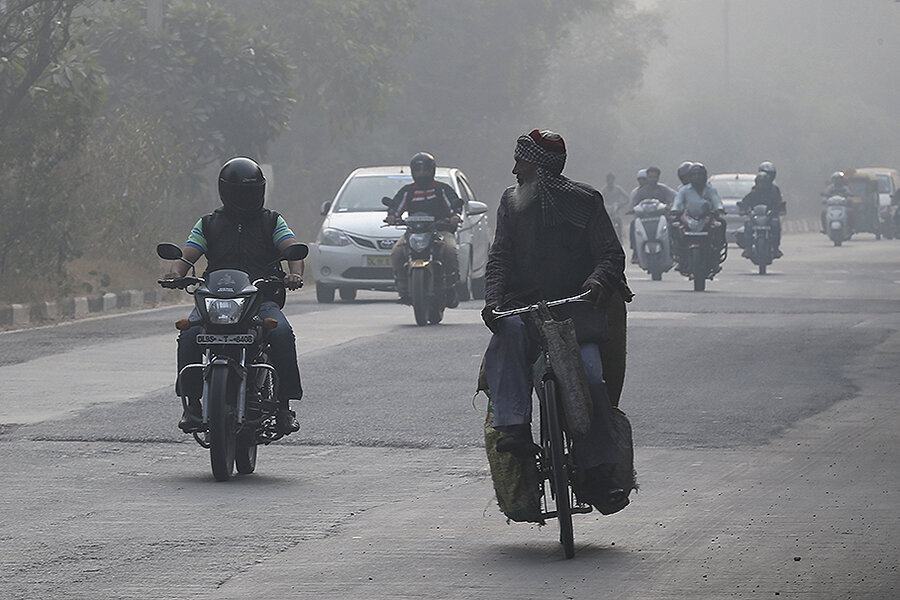Can India make or break climate change?
Loading...
Who's the big, bad wolf of global warming?
Ask an American, and fingers likely point to China: the world's largest consumer and producer of coal, where many cities' serious smog problem has made protective face masks more of a norm than an exception.
Yet China has started to tackle its environmental crisis (or at least to pledge to): investing in more renewable energy, trying out cap-and-trades, and projecting that its CO2 emissions will peak around 2030.
As China points out, it takes a lot of energy to feed, house, and transport the world's largest population. But India is right behind, with 1.28 billion residents to China's 1.37 billion, and climate watchdogs are now warning that Prime Minister Narendra Modi's decisions may make or break not just India's environmental future, but the world's.
On Tuesday, the International Energy Agency released its annual World Energy Outlook, which warned that "Meeting India’s energy needs requires a huge commitment of capital and constant vigilance as to the implications for energy security and the environment."
For the time being, India's emissions per person are just 1.7 metric tons a year, while China's measure 6.7 and the United States, a whopping 17.
But, as the IEA report highlights, India is determined to play developmental catch-up: 75 percent of Indians make less than $75 per month, and the quickest way to remedy that, the government claims, is through efficient, if not sustainable, energy.
Hoping to assuage other countries' worries about a carbon increase, India has pledged to keep emissions to about 9 billion megatons by 2030.
But as the Guardian's Juliette Jowit explains, that's "about one-fifth of the total annual emissions that scientists calculate the world can emit in 2030 and still have a more than a 50 percent chance of avoiding the global temperature rising more than 2C, considered a dangerous threshold."
India is poised to become the world's most populous country as soon as 2022, although previous estimates could not have foreseen that China would do away with its one-child policy. But even 1.5 billion, its projected population in 2030, is less than one-fifth of the projected world total that year: 8.5 billion.
The seeming dilemma of poverty-reducing development "versus" Earth is made more complicated by the already apparent toll global warming has taken in many climates, particularly in some of the world's poorest nations.
On Sunday, the World Bank somberly predicted that 100 million might slip back into poverty over the next decade and a half as a result of climate challenges, from failing crops to higher rates of malaria and diarrhea, thanks to water scarcity – particularly in Africa and Asia, where the Bank says 45 million Indians are at risk.
While wealthy countries urge poorer ones to find earth-friendly development solutions, some developing nations feel that it's time gas-guzzling countries learn to make do with a little less.
And by giving a little more. India has pledged to have 40 percent non-fossil fuel energy by 2030, but insists it can't do it alone. At climate talks in Lima last winter, held in preparation for this month's Paris climate conference, developing countries accused richer ones of reneging on promises to help fund sustainable technology, and also of downplaying the justice debates of climate care: Why should less developed countries pay equally for the environmental sins largely created by their more developed peers?
The problem isn't isolated to island nations like the Maldives, whose citizens worry that their nation is quite literally disappearing into rising ocean waters. Countries still sharply divided between development's haves and have-nots, like China and India, feel that it's unfair for First World partners to mandate limits they themselves didn't have to think about at such a critical stage.
Pope Francis jumped into the climate fray with his May 2015 encyclical, Laudato Si, which makes clear his stance that global warming is a moral issue, as well as a scientific and governmental one, writing "In practice, we continue to tolerate that some consider themselves more human than others, as if they had been born with greater rights."
The encyclical will "make it that much harder for Paris to fail," environmental expert Dan Bodansky told USA Today.








